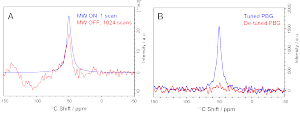In collaboration with Prof. Alex Smirnov and Drs. Sergey Milikisiyants and Antonin Marek we have constructed a quasioptical DNP apparatus operating at 200 GHz/300 MHz microwave/radio frequencies. The centerpiece of our home-built DNP NMR probehead is the integrated photonic band-gap resonator (U.S. Pat. 62/525,888) having Q=250-350, which allows one to obtain 1,500 fold enhancement for HPHT diamonds. Experiments on other samples are underway.

Figure 1. A. A photograph and a sketch of the multi-resonant 200 GHz /300 MHz 1H / 75.5 MHz 13C DNP NMR probehead composed of a double tuned NMR saddle rf coil and a PBG mmW resonator. mmW is delivered via a corrugated waveguide (8 mm ID) connected to a smooth brass taper to reduce the waveguide aperture down to 6.7 mm. A Teflon insert, serving as a dielectric waveguide, pushes the PBG stack against the quartz tube providing a mechanical support for both the rf coil and the resonator. A threaded (1/4-32 thread size) MacorTM plunger moves the sample attached to a mirror inside the quartz tube enabling the resonator tuning. B. Schematics of the double-tuned rf probe circuit. C. Schematics of a quasioptical 200 GHz platform with all active solid-state mmW components as indicated. D. Photograph of the plunger with the driving gear and an HPHT diamond crystal attached to the PBG resonator mirror. E. Photograph of the powdered diamond sample cast in thin polystyrene film on the surface of a round aluminum mirror of 5.7 mm in diameter.

Figure 2. A. Natural-abundance, single-scan 13C NMR signal from HPHT single crystal diamond demonstrates DNP enhancement of ε≈1,500 at 0 dB attenuation of the input W-band signal (150-200 mW incident mmW power at 197.4 GHz and 1,000 s contact time) when compared with 13C resonance detected using direct excitation with 1024 scans and 60 s recycle delay. B. DNP effect at ca. <100 μW incident power (blue line). Even a slight detuning of the PBG resonator (red line) at the same incident power results in a drastic decrease of the DNP effect. All DNP experiments were carried out at room temperature.